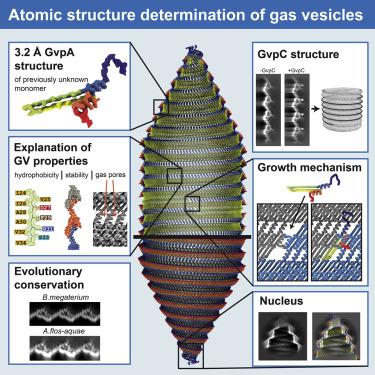Cell ( IF 45.5 ) Pub Date : 2023-03-02 , DOI: 10.1016/j.cell.2023.01.041 Stefan T Huber 1 , Dion Terwiel 2 , Wiel H Evers 1 , David Maresca 2 , Arjen J Jakobi 1

|
Gas vesicles are gas-filled nanocompartments that allow a diverse group of bacteria and archaea to control their buoyancy. The molecular basis of their properties and assembly remains unclear. Here, we report the 3.2 Å cryo-EM structure of the gas vesicle shell made from the structural protein GvpA that self-assembles into hollow helical cylinders closed off by cone-shaped tips. Two helical half shells connect through a characteristic arrangement of GvpA monomers, suggesting a mechanism of gas vesicle biogenesis. The fold of GvpA features a corrugated wall structure typical for force-bearing thin-walled cylinders. Small pores enable gas molecules to diffuse across the shell, while the exceptionally hydrophobic interior surface effectively repels water. Comparative structural analysis confirms the evolutionary conservation of gas vesicle assemblies and demonstrates molecular features of shell reinforcement by GvpC. Our findings will further research into gas vesicle biology and facilitate molecular engineering of gas vesicles for ultrasound imaging.
中文翻译:

用于浮力控制运动的气体囊泡的冷冻电镜结构
气体囊泡是充满气体的纳米室,允许多种细菌和古细菌控制它们的浮力。它们的特性和组装的分子基础仍不清楚。在这里,我们报道了由结构蛋白 GvpA 制成的气体囊泡壳的 3.2 Å 冷冻电镜结构,该结构蛋白自组装成由锥形尖端封闭的中空螺旋圆柱体。两个螺旋半壳通过 GvpA 单体的特征排列连接,暗示了气体囊泡生物发生的机制。 GvpA 的折叠具有受力薄壁圆柱体典型的波纹壁结构。小孔使气体分子能够在外壳上扩散,而异常疏水的内表面则有效地排斥水。比较结构分析证实了气体囊泡组件的进化保守性,并证明了 GvpC 壳强化的分子特征。我们的研究结果将进一步研究气泡生物学,并促进用于超声成像的气泡分子工程。











































 京公网安备 11010802027423号
京公网安备 11010802027423号